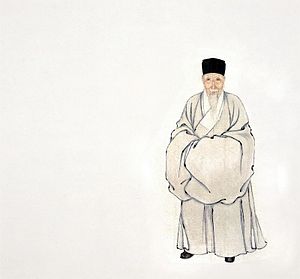art.wikisort.org - Artist
Chen Jiru (simplified Chinese: 陈继儒; traditional Chinese: 陳繼儒; pinyin: Chén Jìrú; Wade–Giles: Ch'en Chi-ju; 1558–1639) was a Chinese landscape painter, calligrapher and essayist during the Ming dynasty (1368–1644).[1]

Chen was born in Huating (华亭;[1] present-day Songjiang District, Shanghai).[2] His courtesy name was Zhongchun (仲醇) and his pseudonyms were Migong (麋公) and Meigong (眉公).[1][3] Chen's calligraphy followed the style of Su Shi and Mi Fu. Chen also painted landscapes and elegant still lifes.
In 1595 he wrote Tea Talks (茶董補), still often quoted in China and Japan, and he studied pottery and created purple clay teapots in the Yixing style. His Shallow Comments on the Art of Nourishing Life as well as A Gentleman's Remarks on Diet were a reference for many years.
He was a notable author of the xiaopin, a form of short literary essay.[4]
Chen Jiru left an autobiography which contains a "patently fictitious account of the circumstances of his own death, a most extraordinary innovation," writes the modern scholar Pei-yi Wu, describing Chen as "a member of the literati known for his versatile artistic talents."[5]
In 2007, Jamie Greenbaum, a researcher at the University of Beijing, published a book[6] on Chen Jiru's writings which provides an overview of his larger-than-life personality, as well as an account of the different literary personae he invented.
References
- Cihai: Page 432.
- "Chen Jiru Brief Biography". Archived from the original on 2008-09-08. Retrieved 2008-07-09.
- "Chen Jiru". Retrieved 2010-02-05.
- Mair 2001. "Introduction: The Origins and Impact of Literati Culture", paragraph 22.
- The Confucian's Progress: Autobiographical Writings in Traditional China (Princeton University Press, 1992) by Pei-yi Wu
- Greenbaum, Jamie (2007). Greenbaum. ISBN 978-9004163584. Retrieved 2010-02-05.
Bibliography
- Ci hai bian ji wei yuan hui (辞海编辑委员会. Ci hai (辞海. Shanghai: Shanghai ci shu chu ban she (上海辞书出版社), 1979.
- Greenbaum, Jamie (2007). Chen Jiru (1558-1639). BRILL. ISBN 978-90-04-16358-4.
- Mair, Victor H. (ed.) (2001). The Columbia History of Chinese Literature. New York: Columbia University Press. ISBN 0-231-10984-9. (Amazon Kindle edition.)
- Hummel, Arthur W. Sr., ed. (1943). . Eminent Chinese of the Ch'ing Period. United States Government Printing Office.
External links
- Works by Jiru Chen at Project Gutenberg
На других языках
[de] Chen Jiru
Chen Jiru (chinesisch .mw-parser-output .Hant{font-size:110%}陳繼儒 / .mw-parser-output .Hans{font-size:110%}陈继儒, Pinyin Chén Jìru; 1558–1639), auch bekannt als Chen Meigong, war ein chinesischer Maler, Kalligraph, Schriftsteller und Dichter während der Ming-Dynastie. Er wurde 1558 in Huating 华亭, heute im Bezirk Songjiang (Shanghai), geboren und starb 1639. Er war auch Experte für Keramik im Zusammenhang mit Tee. Chen Jiru war ein Landschaftskünstler, der auch Stillleben, Pflaumenblüten und Bambus malte. In seiner Kalligraphie folgte er dem Stil von Su Shi (1037–1101) und Mi Fu (1051–1107) aus der Zeit der Song-Dynastie.[1] Chen Jiru zählte mit Dong Qichang und Mo Shilong zu den herausragenden Figuren der Huating-Schule (华亭派 bzw. Songjiang-Schule 松江画派) der Malerei in der Ming-Dynastie. Das Werk Shitong 史通 des Liu Zhiji (661–721) aus der Zeit der Tang-Dynastie gab er in einer revidierten und kommentierten Ausgabe heraus (Shitong dingzhu 史通订注[2]). Viele seiner Schriften erschienen in der Sammlung Baoyantang miji 宝颜堂秘笈.- [en] Chen Jiru
[fr] Chen Jiru
Chen Jiru ou Ch'ên Chi-Ju ou Tch'en Ki-Jou, surnom : Zhongshun, noms de pinceau : Migong, Meigong, Xuetang, Bo Shiqiao, est un peintre chinois du XVIe – XVIIe siècles, né en 1558 à Huating (district administratif de la province du Gansu en Chine) et mort en 1639.[it] Chen Jiru
Chen Jiru[1] (陳繼儒T, 陈继儒S, Chén JìrúP, conosciuto anche come Ch'ên Chi-Ju o Tch'en Ki-Jou, con il nome di cortesia Zhongshun e con gli pseudonimi di Migong, Meigong, Xuetang e Bo Shiqiao; Huating, 5 giugno 1558 – 1639) è stato un pittore, scrittore, calligrafo e poeta cinese.[ru] Чэнь Цзижу
Чэнь Цзижу́ (кит. трад. 陳繼儒, упр. 陈继儒, пиньинь Chén Jìrú, 1558 — 1639) — китайский художник, писатель, каллиграф времён династии Мин.Другой контент может иметь иную лицензию. Перед использованием материалов сайта WikiSort.org внимательно изучите правила лицензирования конкретных элементов наполнения сайта.
WikiSort.org - проект по пересортировке и дополнению контента Википедии